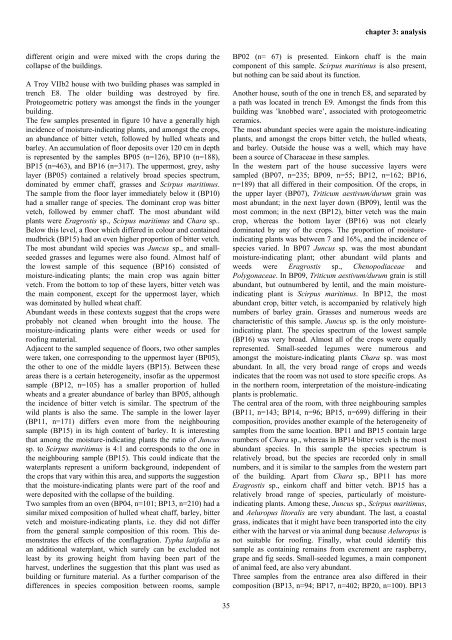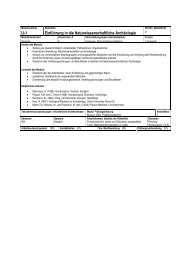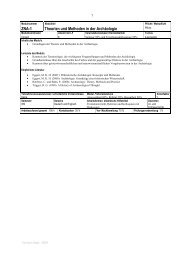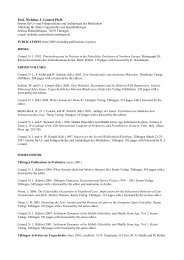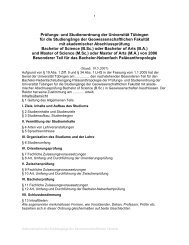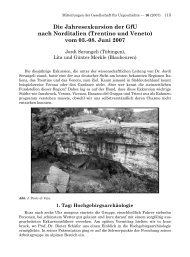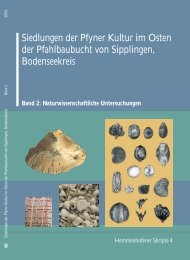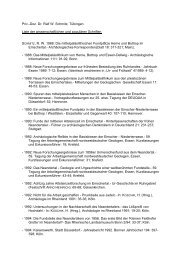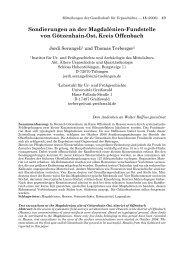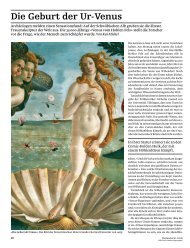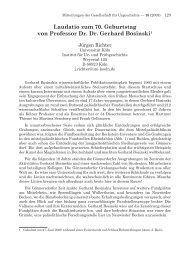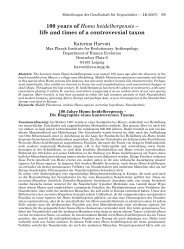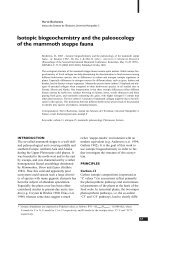bronze age environment and economy in the troad - Universität ...
bronze age environment and economy in the troad - Universität ...
bronze age environment and economy in the troad - Universität ...
Create successful ePaper yourself
Turn your PDF publications into a flip-book with our unique Google optimized e-Paper software.
chapter 3: analysis<br />
different orig<strong>in</strong> <strong>and</strong> were mixed with <strong>the</strong> crops dur<strong>in</strong>g <strong>the</strong><br />
collapse of <strong>the</strong> build<strong>in</strong>gs.<br />
A Troy VIIb2 house with two build<strong>in</strong>g phases was sampled <strong>in</strong><br />
trench E8. The older build<strong>in</strong>g was destroyed by fire.<br />
Protogeometric pottery was amongst <strong>the</strong> f<strong>in</strong>ds <strong>in</strong> <strong>the</strong> younger<br />
build<strong>in</strong>g.<br />
The few samples presented <strong>in</strong> figure 10 have a generally high<br />
<strong>in</strong>cidence of moisture-<strong>in</strong>dicat<strong>in</strong>g plants, <strong>and</strong> amongst <strong>the</strong> crops,<br />
an abundance of bitter vetch, followed by hulled wheats <strong>and</strong><br />
barley. An accumulation of floor deposits over 120 cm <strong>in</strong> depth<br />
is represented by <strong>the</strong> samples BP05 (n=126), BP10 (n=188),<br />
BP15 (n=463), <strong>and</strong> BP16 (n=317). The uppermost, grey, ashy<br />
layer (BP05) conta<strong>in</strong>ed a relatively broad species spectrum,<br />
dom<strong>in</strong>ated by emmer chaff, grasses <strong>and</strong> Scirpus maritimus.<br />
The sample from <strong>the</strong> floor layer immediately below it (BP10)<br />
had a smaller range of species. The dom<strong>in</strong>ant crop was bitter<br />
vetch, followed by emmer chaff. The most abundant wild<br />
plants were Eragrostis sp., Scirpus maritimus <strong>and</strong> Chara sp..<br />
Below this level, a floor which differed <strong>in</strong> colour <strong>and</strong> conta<strong>in</strong>ed<br />
mudbrick (BP15) had an even higher proportion of bitter vetch.<br />
The most abundant wild species was Juncus sp., <strong>and</strong> smallseeded<br />
grasses <strong>and</strong> legumes were also found. Almost half of<br />
<strong>the</strong> lowest sample of this sequence (BP16) consisted of<br />
moisture-<strong>in</strong>dicat<strong>in</strong>g plants; <strong>the</strong> ma<strong>in</strong> crop was aga<strong>in</strong> bitter<br />
vetch. From <strong>the</strong> bottom to top of <strong>the</strong>se layers, bitter vetch was<br />
<strong>the</strong> ma<strong>in</strong> component, except for <strong>the</strong> uppermost layer, which<br />
was dom<strong>in</strong>ated by hulled wheat chaff.<br />
Abundant weeds <strong>in</strong> <strong>the</strong>se contexts suggest that <strong>the</strong> crops were<br />
probably not cleaned when brought <strong>in</strong>to <strong>the</strong> house. The<br />
moisture-<strong>in</strong>dicat<strong>in</strong>g plants were ei<strong>the</strong>r weeds or used for<br />
roof<strong>in</strong>g material.<br />
Adjacent to <strong>the</strong> sampled sequence of floors, two o<strong>the</strong>r samples<br />
were taken, one correspond<strong>in</strong>g to <strong>the</strong> uppermost layer (BP05),<br />
<strong>the</strong> o<strong>the</strong>r to one of <strong>the</strong> middle layers (BP15). Between <strong>the</strong>se<br />
areas <strong>the</strong>re is a certa<strong>in</strong> heterogeneity, <strong>in</strong>sofar as <strong>the</strong> uppermost<br />
sample (BP12, n=105) has a smaller proportion of hulled<br />
wheats <strong>and</strong> a greater abundance of barley than BP05, although<br />
<strong>the</strong> <strong>in</strong>cidence of bitter vetch is similar. The spectrum of <strong>the</strong><br />
wild plants is also <strong>the</strong> same. The sample <strong>in</strong> <strong>the</strong> lower layer<br />
(BP11, n=171) differs even more from <strong>the</strong> neighbour<strong>in</strong>g<br />
sample (BP15) <strong>in</strong> its high content of barley. It is <strong>in</strong>terest<strong>in</strong>g<br />
that among <strong>the</strong> moisture-<strong>in</strong>dicat<strong>in</strong>g plants <strong>the</strong> ratio of Juncus<br />
sp. to Scirpus maritimus is 4:1 <strong>and</strong> corresponds to <strong>the</strong> one <strong>in</strong><br />
<strong>the</strong> neighbour<strong>in</strong>g sample (BP15). This could <strong>in</strong>dicate that <strong>the</strong><br />
waterplants represent a uniform background, <strong>in</strong>dependent of<br />
<strong>the</strong> crops that vary with<strong>in</strong> this area, <strong>and</strong> supports <strong>the</strong> suggestion<br />
that <strong>the</strong> moisture-<strong>in</strong>dicat<strong>in</strong>g plants were part of <strong>the</strong> roof <strong>and</strong><br />
were deposited with <strong>the</strong> collapse of <strong>the</strong> build<strong>in</strong>g.<br />
Two samples from an oven (BP04, n=101; BP13, n=210) had a<br />
similar mixed composition of hulled wheat chaff, barley, bitter<br />
vetch <strong>and</strong> moisture-<strong>in</strong>dicat<strong>in</strong>g plants, i.e. <strong>the</strong>y did not differ<br />
from <strong>the</strong> general sample composition of this room. This demonstrates<br />
<strong>the</strong> effects of <strong>the</strong> conflagration. Typha latifolia as<br />
an additional waterplant, which surely can be excluded not<br />
least by its grow<strong>in</strong>g height from hav<strong>in</strong>g been part of <strong>the</strong><br />
harvest, underl<strong>in</strong>es <strong>the</strong> suggestion that this plant was used as<br />
build<strong>in</strong>g or furniture material. As a fur<strong>the</strong>r comparison of <strong>the</strong><br />
differences <strong>in</strong> species composition between rooms, sample<br />
BP02 (n= 67) is presented. E<strong>in</strong>korn chaff is <strong>the</strong> ma<strong>in</strong><br />
component of this sample. Scirpus maritimus is also present,<br />
but noth<strong>in</strong>g can be said about its function.<br />
Ano<strong>the</strong>r house, south of <strong>the</strong> one <strong>in</strong> trench E8, <strong>and</strong> separated by<br />
a path was located <strong>in</strong> trench E9. Amongst <strong>the</strong> f<strong>in</strong>ds from this<br />
build<strong>in</strong>g was ‛knobbed ware’, associated with protogeometric<br />
ceramics.<br />
The most abundant species were aga<strong>in</strong> <strong>the</strong> moisture-<strong>in</strong>dicat<strong>in</strong>g<br />
plants, <strong>and</strong> amongst <strong>the</strong> crops bitter vetch, <strong>the</strong> hulled wheats,<br />
<strong>and</strong> barley. Outside <strong>the</strong> house was a well, which may have<br />
been a source of Characeae <strong>in</strong> <strong>the</strong>se samples.<br />
In <strong>the</strong> western part of <strong>the</strong> house successive layers were<br />
sampled (BP07, n=235; BP09, n=55; BP12, n=162; BP16,<br />
n=189) that all differed <strong>in</strong> <strong>the</strong>ir composition. Of <strong>the</strong> crops, <strong>in</strong><br />
<strong>the</strong> upper layer (BP07), Triticum aestivum/durum gra<strong>in</strong> was<br />
most abundant; <strong>in</strong> <strong>the</strong> next layer down (BP09), lentil was <strong>the</strong><br />
most common; <strong>in</strong> <strong>the</strong> next (BP12), bitter vetch was <strong>the</strong> ma<strong>in</strong><br />
crop, whereas <strong>the</strong> bottom layer (BP16) was not clearly<br />
dom<strong>in</strong>ated by any of <strong>the</strong> crops. The proportion of moisture<strong>in</strong>dicat<strong>in</strong>g<br />
plants was between 7 <strong>and</strong> 16%, <strong>and</strong> <strong>the</strong> <strong>in</strong>cidence of<br />
species varied. In BP07 Juncus sp. was <strong>the</strong> most abundant<br />
moisture-<strong>in</strong>dicat<strong>in</strong>g plant; o<strong>the</strong>r abundant wild plants <strong>and</strong><br />
weeds were Eragrostis sp., Chenopodiaceae <strong>and</strong><br />
Polygonaceae. In BP09, Triticum aestivum/durum gra<strong>in</strong> is still<br />
abundant, but outnumbered by lentil, <strong>and</strong> <strong>the</strong> ma<strong>in</strong> moisture<strong>in</strong>dicat<strong>in</strong>g<br />
plant is Scirpus maritimus. In BP12, <strong>the</strong> most<br />
abundant crop, bitter vetch, is accompanied by relatively high<br />
numbers of barley gra<strong>in</strong>. Grasses <strong>and</strong> numerous weeds are<br />
characteristic of this sample. Juncus sp. is <strong>the</strong> only moisture<strong>in</strong>dicat<strong>in</strong>g<br />
plant. The species spectrum of <strong>the</strong> lowest sample<br />
(BP16) was very broad. Almost all of <strong>the</strong> crops were equally<br />
represented. Small-seeded legumes were numerous <strong>and</strong><br />
amongst <strong>the</strong> moisture-<strong>in</strong>dicat<strong>in</strong>g plants Chara sp. was most<br />
abundant. In all, <strong>the</strong> very broad range of crops <strong>and</strong> weeds<br />
<strong>in</strong>dicates that <strong>the</strong> room was not used to store specific crops. As<br />
<strong>in</strong> <strong>the</strong> nor<strong>the</strong>rn room, <strong>in</strong>terpretation of <strong>the</strong> moisture-<strong>in</strong>dicat<strong>in</strong>g<br />
plants is problematic.<br />
The central area of <strong>the</strong> room, with three neighbour<strong>in</strong>g samples<br />
(BP11, n=143; BP14, n=96; BP15, n=699) differ<strong>in</strong>g <strong>in</strong> <strong>the</strong>ir<br />
composition, provides ano<strong>the</strong>r example of <strong>the</strong> heterogeneity of<br />
samples from <strong>the</strong> same location. BP11 <strong>and</strong> BP15 conta<strong>in</strong> large<br />
numbers of Chara sp., whereas <strong>in</strong> BP14 bitter vetch is <strong>the</strong> most<br />
abundant species. In this sample <strong>the</strong> species spectrum is<br />
relatively broad, but <strong>the</strong> species are recorded only <strong>in</strong> small<br />
numbers, <strong>and</strong> it is similar to <strong>the</strong> samples from <strong>the</strong> western part<br />
of <strong>the</strong> build<strong>in</strong>g. Apart from Chara sp., BP11 has more<br />
Eragrostis sp., e<strong>in</strong>korn chaff <strong>and</strong> bitter vetch. BP15 has a<br />
relatively broad range of species, particularly of moisture<strong>in</strong>dicat<strong>in</strong>g<br />
plants. Among <strong>the</strong>se, Juncus sp., Scirpus maritimus,<br />
<strong>and</strong> Aeluropus litoralis are very abundant. The last, a coastal<br />
grass, <strong>in</strong>dicates that it might have been transported <strong>in</strong>to <strong>the</strong> city<br />
ei<strong>the</strong>r with <strong>the</strong> harvest or via animal dung because Aeluropus is<br />
not suitable for roof<strong>in</strong>g. F<strong>in</strong>ally, what could identify this<br />
sample as conta<strong>in</strong><strong>in</strong>g rema<strong>in</strong>s from excrement are raspberry,<br />
grape <strong>and</strong> fig seeds. Small-seeded legumes, a ma<strong>in</strong> component<br />
of animal feed, are also very abundant.<br />
Three samples from <strong>the</strong> entrance area also differed <strong>in</strong> <strong>the</strong>ir<br />
composition (BP13, n=94; BP17, n=402; BP20, n=100). BP13<br />
35


